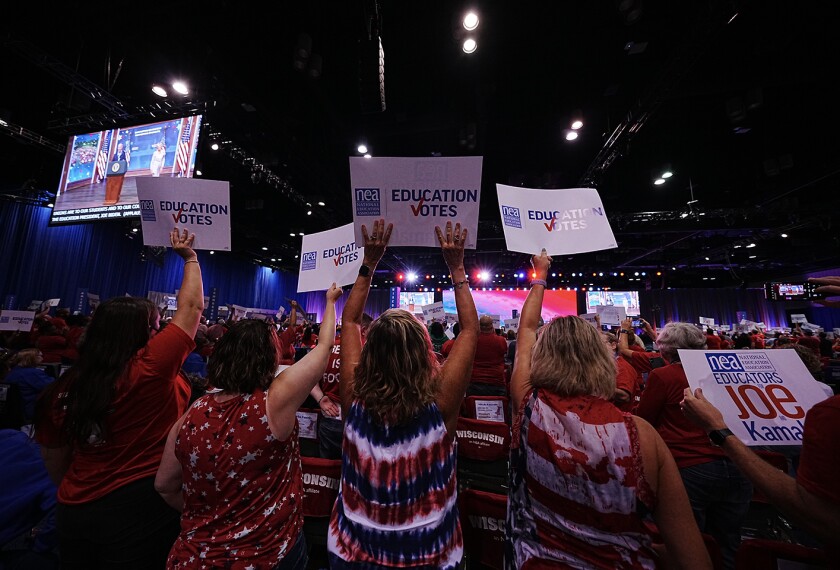As teachers taught from makeshift home classrooms during the pandemic, most dressed “down”—at least on the bottom half. It may have felt like a small, if unintended perk in an otherwise stressful period.
But will that perk carry over into the wide-scale return to in-person learning?
Teachers in a Missouri school district were allowed to continue to dress casually when they returned to work in-person last fall.
“In preparation for the school year, we knew our staff members would take on additional responsibilities—especially with the return to in-person learning,” said Sarah Marriott, the superintendent of the Boonville school district in central Missouri. “We thought about what we could take away that would result in a little less stress [for teachers].”
Historically, change within the K-12 education sphere comes slowly, even on something as seemingly mundane as teacher attire. Then came the pandemic, and school leaders were forced to create completely new ways of operating almost overnight. This massive disruption has given school leaders the opportunity to reflect and perhaps rethink decisions on everything from the practical to the philosophical. The teacher dress code spans both.
Evolution of the teacher dress code
Teacher dress codes themselves are nothing new, although the parameters around them look far different than they did decades ago. An employee contract from the Ohio Education Association, dated 1923 and aimed exclusively at women, forbade female teachers from wearing bright colors or dyeing their hair, and required them to wear “at least two petticoats” and dresses no more than 2 inches above the ankle. Times changed and, with them, teacher dress codes.
But flare-ups over what teachers wear to work have continued and while many schools and districts have relaxed dress codes for staff, some holdouts stick to traditional rules on attire.
In 2018, We Are Teachers compiled “14 Ridiculous Dress Code Rules for Teachers You Won’t Believe Are Real,” from teachers around the world. #1 on the list? Shoes that float are forbidden.
And wearing jeans—common in so many offices and professional workplaces—still remains a treat for special days in many schools.
Fast forward to the pandemic.
Downplaying the dress code during the pandemic
“During the pandemic, I had expectations that all educators would be professionally dressed to set an example to the students, but I didn’t reinforce it to the teachers because there were so many other variables they were dealing with,” said Otis Kitchen II, principal at Town N’ Country Elementary School in Tampa, Fla.
Kitchen says last August, when Town N’ Country returned to in-person learning, teachers had more than usual to manage—from simultaneously teaching students in the building and at home to ensuring the maintenance of health and safety protocols.
“If you add enforcing a dress code, it could negatively impact school culture,” Kitchen said.
As Kitchen’s observations indicate, teacher dress codes represent more than just choosing what to wear to work in the morning.
Peter B. Saunders, principal of Maritime Academy Charter School in Philadelphia, always dressed in a shirt and tie during his years as a teacher in the School District of Philadelphia, even though it wasn’t mandated.
“I guess I wanted to represent myself in a way that delineated who was the student and who was the teacher,” he said.
Now that Saunders is a principal, he takes a pragmatic approach to the teacher dress code.
“Business casual” is the expected attire. But, he says, the school administration encourages teachers to wear comfortable shoes, even sneakers, as teachers are on their feet most of the day. And on Fridays, teachers can dress down a bit more, as long as they are wearing the school T-shirt.
“There are teachers who dress casually and can manage their classrooms with no worries,” Saunders said.
Saunders’ openness regarding teacher attire extends to teaching candidates, whom he sees wearing more casual attire to interviews than in years past.
“Not every person I interview has on a suit or a dress, like they would have a decade ago. But they’re not coming in in flip-flops,” Saunders said. “That would be alarming.”
He recalls a human resources course he took years ago, in which he learned that most hiring managers form a strong opinion of job candidates within seconds of meeting them—a practice he intentionally eschews. “I’m not going to abandon this person because of how they look,” Saunders said.
De-emphasis on dress codes here to stay?
Considering a teaching candidate who’s wearing questionable attire is one thing; reconsidering employees’ dress codes is another. But for some administrators, the pandemic has proved to be the inflection point that could lead to permanent change.
“It has given us an opportunity to take a step back, look at where our priorities are, and possibly establish new norms,” said Kitchen. He adds that, as long as teachers aren’t wearing clothing that’s provocative or offensive and student achievement isn’t suffering, he sees no need to focus on teacher dress code.
As for the Boonville district, which officially relaxed the teacher dress code this year, Marriott reports no negative reaction from the students to the change.
“As a whole, they are just grateful to be in school,” she said.
But Marriott has yet to decide whether the teacher dress code will remain officially relaxed beyond the current school year.
“I need to put more thought into it,” she said. “Once we make that decision, it’s difficult to circle back around.”






